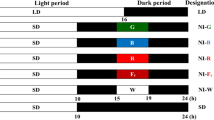Summary
This study concerns the effects of red and far-red light on flowering in the short day plantLemna perpusilla 6746. The critical day length for maximum flowering was found to be 10 hours. Exposure to red light near the middle of the dark period inhibited flowering, and the time of maximum sensitivity to red light occurred 9 hours after the beginning of dark periods of either 14 or 17 hours. The inhibition by red light was not reversible by far-red light, which also inhibited flowering, especially when given early in the dark period. Flowering inhibited by exposure to far-red light at the beginning of the dark period could be restored by subsequent exposure to red light. It appears that two photoperiodic partial processes in some plants may be controlled by the red, far-red reversible pigment system.
Similar content being viewed by others
Literature Cited
Borthwick, H. A.: Photoperiodic control of flowering. In: Photoperiodism and related phenomena in plants and animals,R. B. Withrow edit. Washington: American Association for the Advancement of Science (Publication No. 55) 1959.
Borthwick, H. A., andS. B. Hendricks: Photoperiodism in plants. Science132, 1223–1228 (1960).
Bünning, E., u.G. Joerens: Versuche zur photoperiodischen Diapause-Induktion beiPieris brassicae L. Naturwissenschaften46, 518–519 (1959).
Downs, R. J.: Photocontrol of vegetative growth. In: Photoperiodism and related phenomena in plants and animals,R. B. Withrow edit. Washington: American Association for the Advancement of Science (Publication No. 55) 1959.
Hillman, W. S.: Photoperiodic control of flowering inLemna perpusilla. Nature (Lond.)181, 1275 (1958).
—: Experimental control of flowering inLemna. I. General methods. Photoperiodism inL. perpusilla 6746. Amer. J. Bot.46, 466–473 (1959a).
—: Experimental control of flowering inLemna. II. Some effects of medium composition, chelating agents and high temperatures on flowering inL. perpusilla 6746. Amer. J. Bot.46, 489–495 (1959b).
—: Photoperiodism, chelating agents and flowering ofLemna perpusilla andL. gibba in aseptic culture. In: Light and life,W. D. McElroy andB. Glass edit. Baltimore: Johns Hopkins Univ. Press 1960.
Hutner, S. H.: Comparative physiology of heterotrophic growth in plants. In: Growth and differentiation in plants,W. E. Loomis edit. Ames: Iowa State College Press 1953.
Kandeler, R.: Über die Blütenbildung beiLemna gibba. L. II. Das Wirkungsspektrum von blühförderndem Schwachlicht. Z. Bot.44, 153–174 (1956).
Mohr, H., u.G. Schoser: Eine Interferenzfilter-Monochromatoranlage für photobiologische Zwecke. Planta (Berl.)53, 1–17 (1959).
Nakayama, S.: Studies on the dark process in the photoperiodic response ofPharbitis seedlings. Sci. Rep. Tohoku Univ., Ser. Biol.26, 137–183 (1958).
—,H. A. Borthwick andS. B. Hendricks: Failure of photoreversible control of flowering inPharbitis nil. Bot. Gaz.121, 237–243 (1960).
Salisbury, F. B., andJ. Bonner: The reactions of the photoinductive dark period. Plant Physiol.31, 141–147 (1956).
Author information
Authors and Affiliations
Additional information
With 5 Figures in the Text
Rights and permissions
About this article
Cite this article
Purves, W.K. Dark reactions in the flowering ofLemna perpusilla 6746. Planta 56, 684–690 (1961). https://doi.org/10.1007/BF01928211
Received:
Issue Date:
DOI: https://doi.org/10.1007/BF01928211




